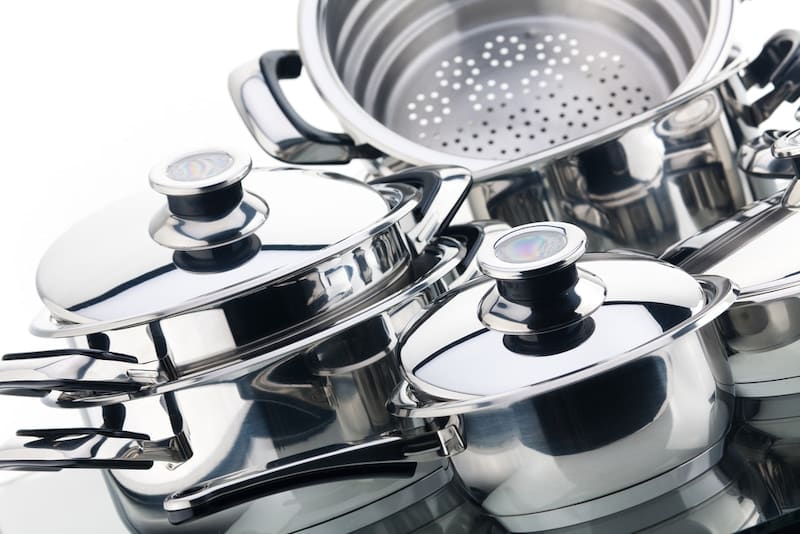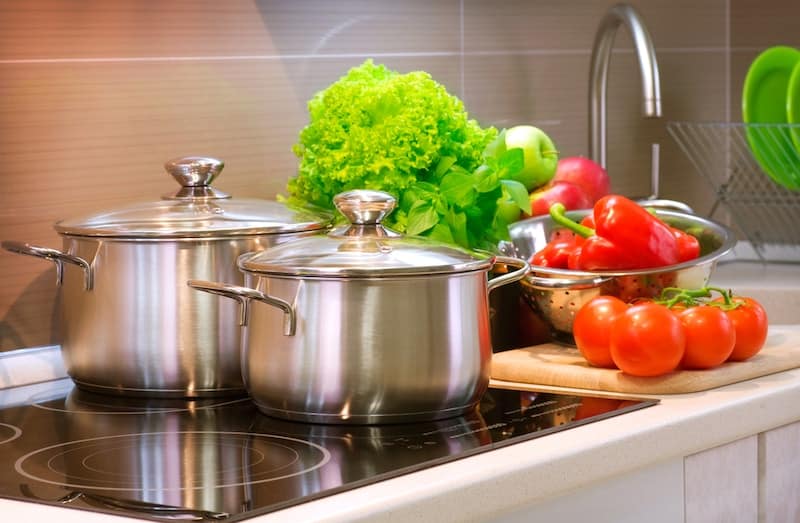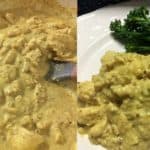Cookware is something most people use on a daily basis, and stainless steel is one of the most commonly used cookware. This is mainly because most people believe it is safe and does not leach any harmful chemicals into the food.
So, is stainless steel cookware actually safe? Yes, it is quite safe provided you are well-aware of how to choose the right type of stainless steel and how to use it safely. Cookware made of nickel-free stainless steel is the safest but, at the same time, are more prone to corrosive attacks. They are more expensive and a bit hard to find as well. In general, cookware made of 300 series stainless steel are non-toxic to use as long as you don’t use it for cooking acidic foods at extremely high temperatures.
If you are looking for safe and reliable cookware for you and your family, continue reading. This article will answer all your queries in-depth from what stainless steel cookware actually contains whether or not it is suitable for use on a glass top stove.
Why Cookware Matters

With each passing day, more and more people are getting interested in buying kitchenware free from toxins which otherwise negatively impact their bodies. Liver inflammation, dementia, cancer, and ulcers are some diseases linked to toxins found in cookware.
Some of the most harmful types of cookware include cookware with copper or aluminum surfaces and Teflon-coated pans. The latter contains PFOA and PTFE which are both extremely dangerous to health. Aluminum-coated cookware is associated with excessive leaching and has strong ties with Alzheimer’s disease. The same is true for copper which leaches into the food through copper-coated cookware and induce heart problems.
Fortunately, there are many types of cookware that you may safely use without being worried about these gruesome illnesses, one of them being stainless steel. While there is a lot of debate going on regarding stainless steel cookware, it is actually quite safe if used properly.
What is Stainless Steel Cookware Made of?
Before discussing the safety of stainless steel cookware, it is important to understand what steel really is and how is it made.
Stainless steel refers to a steel alloy containing at least 10.5% of chromium. It is extremely lustrous and exhibits high resistance to staining and corrosion. For further enhancement of its properties, other alloying elements such as titanium, copper, molybdenum, and nickel are also added to it. By far, more than 150 different types of stainless steel grades exist, each with a different combination of metals in its composition.
Types of Food Grade Stainless Steel
According to international standards, the following types of steel grades have been rendered safe for food preparations. Most of the stainless steel cookware available in the market majorly comprises of one of these types.
200 Series
For reducing the total cost of production, some unreliable cookware manufacturing companies substitute nickel with manganese. Such type of cookware is said to be included in the 200 series of stainless steel. This series is also known as the non-magnetic series and produces cheaper cookware that is still safe for cooking food. However, because they are highly prone to corrosion, many food experts advise against using them.
300 Series
The 300 series stainless steel comes in two subtypes both of which are safe for preparing food.
304 Stainless Steel
When it comes to choosing safe cookware, the 304 series is the most common stainless steel series chosen by most users. This series comprises of non-magnetic, highly lustrous cookware because of a high nickel and chromium content. It also has a better resistance towards corrosion and rust. The only disadvantage of the 304 series is that it rusts more rapidly when exposed to salt.
As per the flatware grading system, the 304 stainless steel cookware comes in two subtypes i.e. 18/8 and 18/10. The first number represents the total amount of chromium present in the cookware whereas the second number depicts the total nickel content. For example, the18/10 stainless steel cookware will contain 18% of chromium and 10% of nickel. Similarly, 18/8 stainless steel cookware will have 18% of chromium and 8% of nickel in its composition. Because the difference between the total amounts of nickel and chromium is 2% only, the performance of both types is almost the same with hardly any noticeable difference.
316 Stainless Steel
The 316 stainless steel is a high-quality alloy popular for its extraordinary resistance to corrosion. It is also known as marine stainless steel as it has shown high resistance to corrosion secondary to salt exposure and proven itself favorable for usage in marine applications. The 316 stainless steel also serves many medicinal purposes and is also referred to as the surgical stainless steel.
What gives the 316 stainless steel extra durability and resilience is the addition of a very small amount of molybdenum in its composition. In general, this type of steel comprises 16 to 18 percent of chromium and 10 to 14 percent of nickel in addition to 2 percent of molybdenum. This makes the 316 stainless steel very expensive and only high-end cookware manufacturers use it.
400 Series
The 430 stainless steel, a popular addition to the 400 series, is completely nickel free. According to the flatware grading system, it is also known as the 18/0 since it has 18% chromium with no nickel in it.
Although commercially termed as “nickel-free”, it is important to remember that the 430 stainless steel does contain a negligible amount of nickel in it, approximately 0.75%.
Because of an absence of nickel, the 430 series is prone to corrosion and tends to lose its luster with time.
Is Stainless Steel Cookware Safe to Cook with?
The answer is yes but you must be familiar with a few things in order to use stainless steel cookware with complete safety.
Stainless steel is considered as safe for food contact as per the Food and Drug Administration (FDA) as long as it contains at least 16% of chromium in it. While some people may consider it as inert, the fact is it is safer and a lot stable than other reactive cookware such as aluminum and copper.
Let’s discuss the safety issues regarding the use of stainless steel as cookware.
Chromium Leaching
So far, no tolerable upper intake level has been established for chromium, mainly because it has not been associated with adverse effects at any level. However, the recommended daily intake of this metal ranges between 50 to 200 mcg for adults.
You may not know it but the human body actually needs chromium in small quantities. Most of this requirement is fulfilled by the dietary intake of potatoes, broccoli, poultry, beef, apples, and dairy products.
This means that if using stainless steel cookware helps leech chromium to our culinary foods, we might be possibly getting more chromium that our bodies actually need. According to a study performed in 2013, using stainless steel does leach nickel and chromium into the foods, raising concerns in people about using it in everyday cooking.
Nickel Leaching
Nickel leaching is something worse than chromium getting added to the food. Nickel is an important part of the Substance Priority List (SPL) issued by the Agency for Toxic Substances and Diseases Registry (ATSDR). The human body requires nickel in trace amounts only and most of us are already getting it from a diet rich in grains, chocolate, and nuts. Additionally, appliances like coffee machines and crockpots made of stainless steel also contribute to this.
Research supports the fact that using stainless steel cookware can provide the bod with a noticeable amount of nickel, iron, and chromium. Considering all the possible sources providing the body with nickel, it can be rightly assumed that we are getting more nickel than the recommended daily amount of 25 to 35 mcg.
Constant exposure to high levels of nickel is linked to the possibility of getting allergies, lung disorders, eczema, and even certain types of cancer.
Controlling Stainless Steel Reactivity
Because there is a possibility of contaminating food with nickel and chromium with stainless steel cookware, should it be avoided completely? Not really.
Unless you have high sensitivity to these metals, it is still possible to use cookware made of stainless steel as long as you take special care while buying and utilizing them.
- If you wish to purchase stainless steel cookware with less amount of nickel, try performing a magnet test. If the magnet sticks to the insides, bottom, and sides of the pot, it means it is nickel-free.
- Sometimes the pots and pans made with stainless steel have an additional layer of aluminum in them which may lead to leaching if damaged. So if you are buying stainless steel cookware, make sure not to damage its surface.
- Prefer buying stainless steel grades of 18/0 or 18/8 in order to minimize the risks of nickel leaching. Ideally, look for cookware with 400 stainless steel series but 300 series can also work. Try to avoid the 200 series at all costs.
- If you wish to slow-cook your meal, refrain using stainless steel cookware. Moreover, do not cook acidic dishes, for example, meals containing tomato-based sauces, at high temperatures to avoid leaching.
- Take out your meal out of the stainless steel cookware as soon as you are done.
- Avoid using scouring pads, abrasive detergents, and steel wool for cleaning stainless steel pots. To remove the food stuck in the pots, soak them in water in order to soften it. Now use a soft sponge to get rid of the scrapes.
Pros and Cons of Using Stainless Steel
Now that you know how stainless steel can be safely used for cooking as long as you know how to choose, use, and maintain the pots, let’s take a look at the pros and cons of introducing stainless steel cookware to your kitchen.
Pros
The following benefits are associated with using stainless steel cookware:
- They are easy to clean and maintain
- They last longer if taken care of properly
- The magnetic property of stainless steel cookware
- They can be safely used on the stove, broiler, and the oven
- They are available in different forms and sizes
- They are comparatively non-reactive if used with care
- They are more durable and possess high resistance to scratching, corrosion, denting, and rust
- They have a lustrous, polished appearance that looks great in the kitchen
- They are recyclable
- They can be safely placed in a dishwasher
Cons
- They tend to discolor upon exposure to high temperatures or salty foods
- They are poor conductors of heat and require an additional core of copper or aluminum to enhance the conductivity
- The high-quality stainless steel cookware is extremely expensive yet lasts a lifetime
- They are not non-stick and often requires a proper seasoning along with good temperature maintenance in order to prevent food from sticking to the bottom
- Leaching may occur in cookware made up of low-quality stainless steel
Is Stainless Steel Cookware Safer than Aluminum?
The features of cookware made from stainless steel and aluminum are completely different from one another. The aluminum cookware usually comes with a non-stick coating in contrast to the stainless steel cookware that does not contain this feature.
The cookware made of stainless steel is more versatile and can be used to prepare different types of food. On the other hand, aluminum cookware is not so suitable for versatile use but can be effectively utilized for baking purposes.
Although both types of cookware can be safely used in the oven, stainless steel is said to resist heat a lot more than aluminum which is a far better heat conductor than the former.
Considering the features mentioned above, both types of cookware can be safely used in the kitchen. If you are looking for cookware for heavy usage which is non-reactive to foods as well, go for stainless steel. On the contrary, if you prefer lightweight cookware with non-stick features, choose pots made of aluminum. Both types of cookware are safe and can make your cooking experience a lot easier.
Is Stainless Steel Cookware Safer than Ceramic?
The usage of ceramic cookware is increasing with every passing day. Yet, there are many who still prefer to stand by stainless steel. Of course, there are many other choices of cookware too but these two seem to top all of them.
But which one is better among them? Is stainless steel cookware safer than ceramic? The fact is, both types of cookware are food, each with its own pros and cons.
The main difference between cookware made of stainless steel and ceramic is its ability to absorb. Ceramic cookware is a great option if you wish to cook food at low-heat whereas stainless steel is the best for high-temperature cooking. Another difference between the two is that any type of utensil can be used in stainless steel whereas, in ceramic, you can only use silicone, nylon, and wooden utensils.
Regardless of the differences between the two, both ceramic and stainless steel cookware are easy to use as they contain natural materials and would not leach any harmful substances provided you use them carefully. Ceramic cookware definitely has the edge over stainless steel in this respect as it is safer if you are particularly worried about metal particles leaching into your food.
If you wish to be extra careful about metals releasing into your food, prefer using ceramic cookware. Beware of the glazed and colored ceramic pots as they contain harmful substances such as cadmium or lead.
Is Stainless Steel Cookware Safe for Glass Top Stoves?
Glass stovetops are trending lately due to their delicate, gleaming look. However, these glass top stoves have certain limitations that other stoves, for example, electric coils or gas stoves, do not have.
One such limitation is that they are only able to heat the surfaces that are directly in contact with heated elements on the top. Cookware that is bigger in size and stretches far beyond these elements may not be heated well. This means the food in those portions of the pot will not be cooked properly or may take a lot more time.
Stainless steel cookware is among the most popular choices to use on a glass stovetop. The main reasons behind it include factors that such it is moderately priced, extremely durable, and maintains its shine. Moreover, stainless steel cookware does not usually corrode or react with food that easily.
The only downside to using stainless steel on a glass top stove is that it may not be able to efficiently conduct heat. Fortunately, this disadvantage has been overcome by companies by mixing aluminum or copper core at the bottom of all pots and pans made with stainless steel.
All of the reasons mentioned above make stainless steel cookware extremely suitable for use on glass stovetops. Make sure to buy pots with a flat, smooth surface in order to ensure proper cooking.
Related Questions
Is Stainless Steel Nonstick?
Unfortunately, stainless steel does not possess nonstick properties. Food is going to stick to the bottom of the pan if you do not control the temperature properly. However, you can properly season these pans to avoid the food from sticking. To ensure your pan has reached the right temperature, you need to understand the Leidenfrost effect.
Leidenfrost effect, commonly known as the water droplet trick, can be used to determine if your pan has been heated to the right temperature. Once you think that the pan is hot enough, try adding a drop of water and observe what happens to it.
- If the drop of water bubbles up and evaporates immediately, this means the pan is cold
- If the drop of water breaks into smaller droplets and starts skittering across the pan before it evaporates, this means the pan is too hot
- If the drop of water splits into smaller drops and evaporates without skittering, the pan is heated to the right temperature
How to Season a Stainless Steel Pan?
You can easily season a stainless steel pan to avoid the food from sticking to the bottom. Here are the steps to do it properly:
- Turn on the stove to medium heat and place the pan over it for a few minutes
- Add any high-heat oil to it and swirl the pan in order to properly coat it with oil
- Once you see the oil smoking, turn off the heat and let the pan cool down
- Pour the oil out of the pan and use a paper towel to wipe off the excess
Is Stainless Steel a Good Conductor of Heat?
On its own, stainless steel is not a good conductor of heat. To overcome this deficiency, most cookware made of stainless steel also has a copper or aluminum core in order to conduct heat safely and smoothly.
Can You Use Stainless Steel Cookware with Induction Cooktops?
Certain types of stainless steel cookware are good to use with induction cooktops but others may not. Because induction cooktops use the power of magnetism, the cookware you are using must also possess magnetic abilities.
Stainless steel cookware having high levels of nickel is not magnetic. So if you wish to buy cookware for induction cooktops, prefer buying stainless steel pots with low nickel content such as those with 18/0 or 18/8 grades.
Does Stainless Steel Cookware Rust?
Stainless steel cookware has good resistance towards rust as compared to other materials like carbon steel and cast iron. However, this does not necessarily mean that they won’t ever rust.
If one of your stainless steel pots has rusted, mix some baking soda in water to form a paste. Apply this paste to the rusty pot and gently scrub it in order to get rid of the rust without damaging the pot.
Concluding Thoughts
Stainless steel cookware is an absolute must to add luster and shine to your kitchen. Not only are these pots and pans safe for cooking meals but also a great option for safety, functionality, and convenience. Use it on a glass stovetop or try it on induction cooktops, stainless steel is going to make you delicious meals that are safe for the body. Don’t forget to follow the precautionary measures while buying, maintaining, and using these pots for extra safety.













